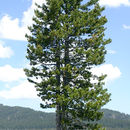fi
nimet breadcrumb-navigoinnissa


Şimali Amerika nın şimal-qərbində bitir. Hündürlüyü 25 m-ə qədər olan, düz, piramida çətirli ağacdır. Gövdəsi nazik, açıq-qonur rəngli, hamardır, diametri 40 sm-dir. Açıq yaşıl rəngli, uzunluğu 5-7 sm olan iynəyarpaqları cüt-cüt yerləşən cod, çox vaxt burulmuş formalıdır. 4-5 il yaşayır. Qozaları qonur və ya qırmızı-qonur rəngli, uzunsov-yumurtavarı formalıdır, uzunluğu 6 sm-dir. Zoğa yapışıb, budaqlarda 10 ilə qədər qalır. Alt budaqları tez məhv olur, ancaq ağacda uzun müddət qalır. Qışda ağacın sıx çətiri çoxlu qarı uzun müddət üzərində saxladığına görə, qar əriyən vaxt ağırlıq nəticəsində ağacların kökündən qopmasına səbəb olur. Soyuğa və kölgəyə davamlıdır, tez böyüyür, torpağa az tələbkardır, ancaq rütubətli tropaqlarda yaxşı inkişaf edir. Mədəni şəraitdə 1854-cü ildən becərilir. Son dövrlərdə respublikamızda yaşıllaşdırmada rast gəlinir.
Деревья и кустарники СССР. т.3.1954; Флора Азербайджана. т.5. 1954; Azərbaycanın ağac və kolları. III cild. 1970; Azərbaycanın “Qırmızı” və “Yaşıl Кitabları”na tövsiyə olunan bitki və bitki formasiyaları. 1996; Azərbaycan florasının konspekti. I-III cildlər. 2005; 2006; 2008.
Şimali Amerika nın şimal-qərbində bitir. Hündürlüyü 25 m-ə qədər olan, düz, piramida çətirli ağacdır. Gövdəsi nazik, açıq-qonur rəngli, hamardır, diametri 40 sm-dir. Açıq yaşıl rəngli, uzunluğu 5-7 sm olan iynəyarpaqları cüt-cüt yerləşən cod, çox vaxt burulmuş formalıdır. 4-5 il yaşayır. Qozaları qonur və ya qırmızı-qonur rəngli, uzunsov-yumurtavarı formalıdır, uzunluğu 6 sm-dir. Zoğa yapışıb, budaqlarda 10 ilə qədər qalır. Alt budaqları tez məhv olur, ancaq ağacda uzun müddət qalır. Qışda ağacın sıx çətiri çoxlu qarı uzun müddət üzərində saxladığına görə, qar əriyən vaxt ağırlıq nəticəsində ağacların kökündən qopmasına səbəb olur. Soyuğa və kölgəyə davamlıdır, tez böyüyür, torpağa az tələbkardır, ancaq rütubətli tropaqlarda yaxşı inkişaf edir. Mədəni şəraitdə 1854-cü ildən becərilir. Son dövrlərdə respublikamızda yaşıllaşdırmada rast gəlinir.
El Pinus contorta subsp. murrayana (sinónimos, P. contorta var. murrayana, pino tamarack o, en inglés, Sierra Lodgepole Pine) es una subespecie del Pinus contorta que aparece en la Cordillera de las Cascadas, en Sierra Nevada y en las sierras adyacentes, y su área de distribución va desde el sur del estado de Washington hasta la parte septentrional de Baja California.
Se utiliza para reforestar en zonas de cordillera, se adapta muy bien a los climas húmedos y fríos de la región cordillerana de la provincia del Neuquén, República Argentina.
En promedio logra alcanzar los 36 m de altura y 90 cm de radio, se han encontrado ejemplares con más de 400 años de vida en el país del norte.
El Pinus contorta subsp. murrayana (sinónimos, P. contorta var. murrayana, pino tamarack o, en inglés, Sierra Lodgepole Pine) es una subespecie del Pinus contorta que aparece en la Cordillera de las Cascadas, en Sierra Nevada y en las sierras adyacentes, y su área de distribución va desde el sur del estado de Washington hasta la parte septentrional de Baja California.
Se utiliza para reforestar en zonas de cordillera, se adapta muy bien a los climas húmedos y fríos de la región cordillerana de la provincia del Neuquén, República Argentina.
En promedio logra alcanzar los 36 m de altura y 90 cm de radio, se han encontrado ejemplares con más de 400 años de vida en el país del norte.
Sosna Murraya (P. contorta subsp. murrayana) – podgatunek drzewa iglastego z rodziny sosnowatych (Pinaceae). Sosna Murraya występuje na terenie USA w górach Sierra Nevada, Górach Kaskadowych i Klamath Mountains (stany: Waszyngton, Kalifornia, Oregon) oraz w Meksyku w Kalifornii Dolnej.
Nazwa podgatunku pochodzi od Andrew Murraya (1812–1878), szkockiego botanika i znawcy drzew iglastych.
Igły pozostają na drzewie przez 3–8 lat. Szyszki nasienne dojrzewają w ciągu 14–18 miesięcy od zapylenia, uwalniają nasiona i opadają wkrótce potem.
Najlepiej rośnie na terenach górzystych (400-3500 m n.p.m.), ze średnimi opadami deszczu. Dobrze znosi chłód ale nie lubi gorącego lata. Toleruje stanowiska nasłonecznione i półcieniste.
Synonimy[3]: Pinus murrayana Balf., P. contorta var. murrayana (Balf.) Engelm., P. bourcieri Carrière, P. tamrac A Murray.
Pozycja podgatunku w obrębie rodzaju Pinus[5]:
Sosna Murraya klasyfikowana jest jako P. contorta subsp. murrayana, chociaż pod względem występowania, wyglądu i zapachu różni się od typowej sosny wydmowej (P. contorta).
Międzynarodowa organizacja IUCN umieściła gatunek Pinus contorta, a tym samym ten takson, w Czerwonej księdze gatunków zagrożonych, przyznając mu kategorię zagrożenia LC (Least Concern, niskie ryzyko wyginięcia)[2].
Sosna Murraya (P. contorta subsp. murrayana) – podgatunek drzewa iglastego z rodziny sosnowatych (Pinaceae). Sosna Murraya występuje na terenie USA w górach Sierra Nevada, Górach Kaskadowych i Klamath Mountains (stany: Waszyngton, Kalifornia, Oregon) oraz w Meksyku w Kalifornii Dolnej.
Nazwa podgatunku pochodzi od Andrew Murraya (1812–1878), szkockiego botanika i znawcy drzew iglastych.